Do you want to know how to use the What Are the Odds Tool in DNA Painter? In this post, learn how to use this tool to find out how someone might fit into your family tree.
In order to explain how the tool works, how to use it, and what you can learn from it, I will use an example from my own family tree.
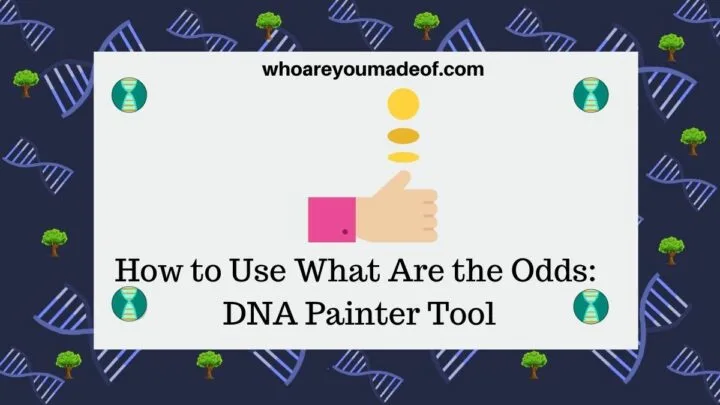
For the past couple of years, I have been working on a bit of a DNA match mystery. Two close relatives have a DNA match that shares 76 centimorgans (cMs) and 364 cMs with them, respectively.
This particular DNA match caught my attention for two reasons. First, since my relatives are full siblings and are related to this genetic relative in the same way, I thought it was interesting that they share such a different percentage of their DNA with the match.
The second reason that I found this match interesting was that this individual has a family tree going back as far as his great-great grandparents and it doesn't include any surnames or people that I recognize. If this person shares 364 centimorgans of DNA, or almost 5% of their DNA, with my relative, then it is unlikely that their common ancestor is further back than a great-great grandparent.
If none of my relative's great-great grandparents match any of this DNA match's great-great grandparents, and no other names seem to match, there is only one conclusion I could come to: one of us has the wrong ancestor in our tree.
Initially, I approached the question as objectively as possible. So, I investigated the possibility of a mistake in my family tree and spent a great deal of time trying to "prove" this - with no success.
With the theory that there must be an incorrect ancestor in our DNA match's tree, I decided to try out the What Are The Odds (also called WATO), one of the many tools on DNA Painter.
Below, I will walk you through how to use the What Are The Odds Tool on DNA Painter to test a hypothesis just like the one I described above.
Important: Sometimes, we just want to know where our DNA matches likely fit into our tree for our own knowledge. We should not tell our DNA matches that we think that they have the wrong ancestors in their tree.
What can the What Are The Odds Tool tell you?
The What Are The Odds Tool can help you determine where in your family tree a DNA match could possibly fit, and provide probabilities for each potential spot in your tree. The probabilities are calculated based on family tree information that you enter and the amount of shared DNA that the match shares with people in the tree.
There are other ways you can use WATO to test different hypotheses, but the essence of the way you use the tool is the same.
Note: In order to use WATO, you should create a free DNA Painter account, and you should have DNA results available from one of the major autosomal DNA testing companies (like Ancestry DNA or 23andMe).
What information do you need to have to use What Are The Odds
In order to use the tool and have it provide useful information to you, you should have a "target" DNA match in mind. This would be the person whose spot in your family tree you would like to determine.
You will also need to know how much DNA you, or other people in your family, share with this DNA match. In addition, you should be sure about how these other family members are related to you.
Finally, you will need to have your family tree in the form of a GEDCOM file, which will save you time. If your family tree is on Ancestry, you can easily export your family tree into a GEDCOM file.
Alternatively, if you would rather not upload your tree, you can manually enter in the ancestors and relatives in the line that you are investigating.
How to check a research question using DNA Painter's What Are The Odds
In order to learn to use the What Are The Odds Tool, you must enter a target name and year of birth, research question, build a small tree (or upload your GEDCOM), and enter in the amount of shared DNA that your target DNA match shares with at least one person in the family tree.
The first thing that you will want to do is choose a target DNA match. This is the person whose relationship to you (or someone else in your tree) you would like to determine.
Then, you will want to enter in your research question. For our example, I'm calling my mystery match "W.L.", and I want to know how he might be related to "BP", and so my research question is "How is WL related to BP?".
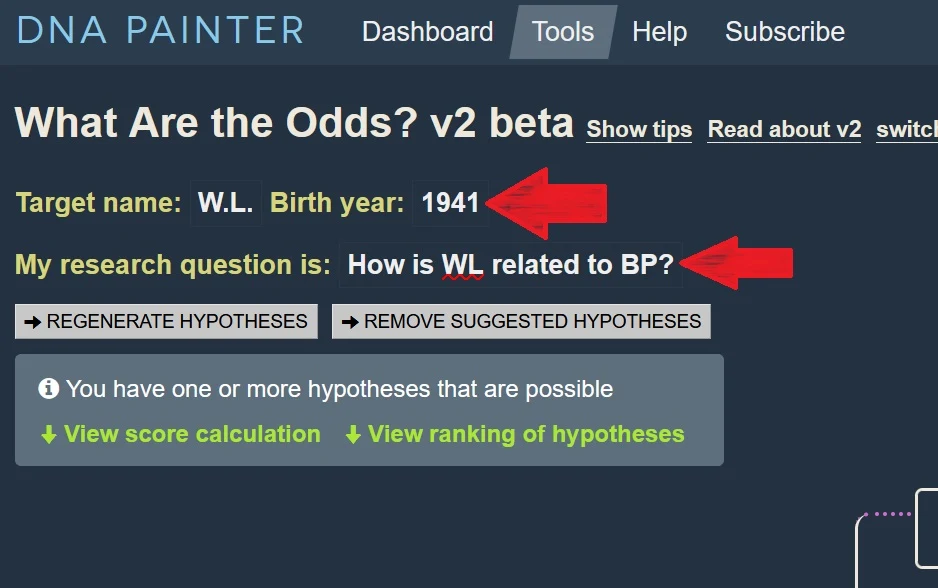
Then, I must upload my GEDCOM. I decided to save some steps and download my tree from Ancestry.
It is important that your family tree includes as many of your collateral lines as possible. For example, include the siblings of your parents, grandparents, great-grandparents, etc.
If possible, include the children of those collateral relatives, include their year of birth and death. This will help WATO provide you with more accurate hypotheses.
During the process of importing my GEDCOM, the tool prompted me to choose the ancestors from whom I think my DNA match is descended. This means that if you create a simple family tree manually, you only need to enter in the branch of your family tree where you believe your DNA match belongs.
For example, if you know that your close DNA match is on your father's side because they don't share any of your maternal matches, you leave off your mother's side of the family tree. In addition, if you feel confident that the match is related to your paternal grandfather and not your paternal grandmother, you can leave off addition lines of your tree.
Once your GEDCOM is imported, you should then enter in the amount of DNA that your match shares with at least one family member who is in your tree. If more than one person in your family tree has tested their DNA and you know how much DNA they share with the target match, enter as many as you can.
Of course, this means that you will need to be sure that those relatives who have tested their DNA are in your family tree. You can add them manually to your imported tree, if you need to, by hovering over the name of their parent and selecting "Add Child".
Finally, once you have completed all of these steps, you are ready to generate hypotheses and examine the ways in which your DNA match might fit into your tree. If at any point you change the tree by adding a new person or adding a new match, you should click the "Regenerate Hypotheses" button to have WATO analyze your data and come to fresh conclusions.
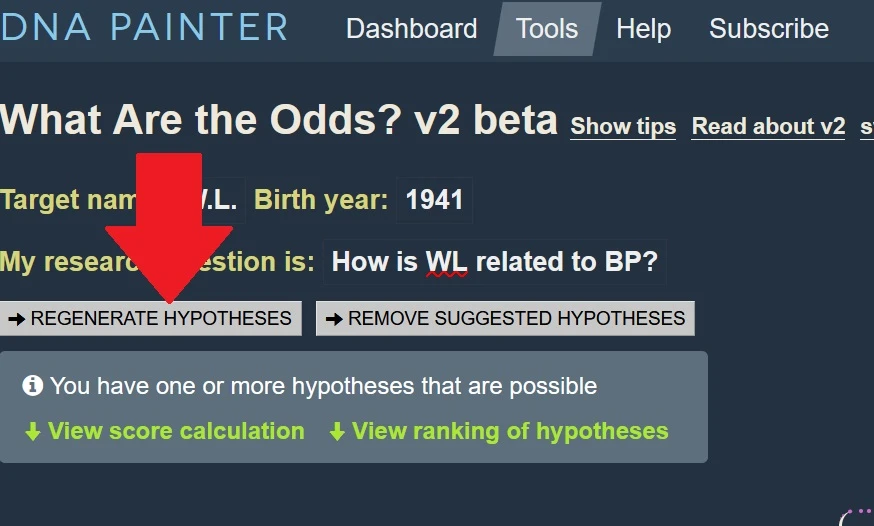
How to understand What Are The Odds Results
Once you have completed all of the steps in the previous section of this post, you will be able to view the hypotheses that the tool has generated based on the inputs that you gave it. There will likely be multiple hypotheses, which will mean that the tool is suggesting multiple ways in which the match could be related.
Each hypothesis will have a corresponding score. The higher the score, the more likely it is to be true.
However, a hypothesis with a low score can also be true. We can use outside information to help narrow down possibilities.
The image below shows just a selection of the hypotheses generated by WATO. Florence and Walter are siblings of one of my ancestors.
The image shows a few of the hypotheses suggest that my mystery DNA match, W.L., could be the child of Frances or Julia, or an unknown child of Florence. It is less likely that the DNA match is a grandchild of the unknown child of Florence (assuming such a child exists), Frances, or Julia.
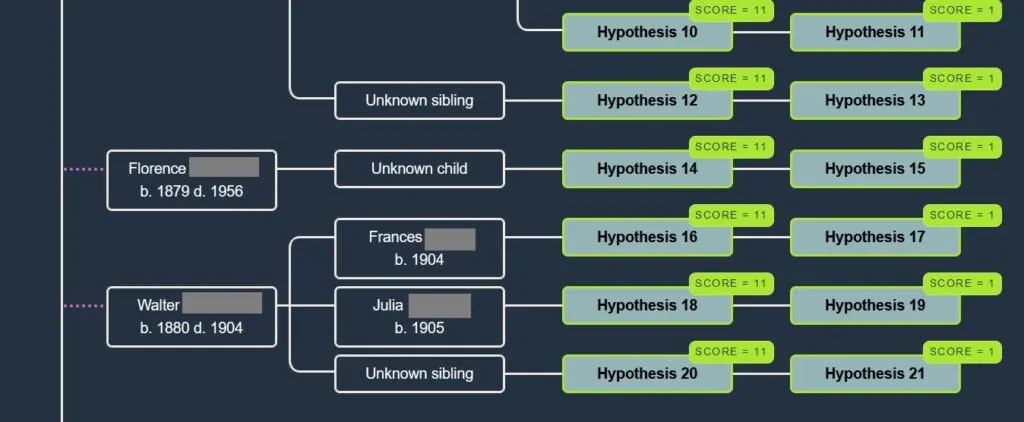
WATO populates unknown siblings, half-siblings, and children into the tool in order to create these hypotheses. If it says "Unknown Sibling", it could be a person that you didn't include in your tree (so, a known child that wasn't added to your tree).
An unknown half-sibling is a more likely scenario, since most people know about their full siblings. However, it is also possible for people to have unknown full siblings.
To view a list of the possible hypotheses and details about the estimated relationships, click "View ranking of hypotheses". You will then see a complete list of each hypothesis and the relationship of your match for each hypothetical place in the tree to you (or the person you are researching for).
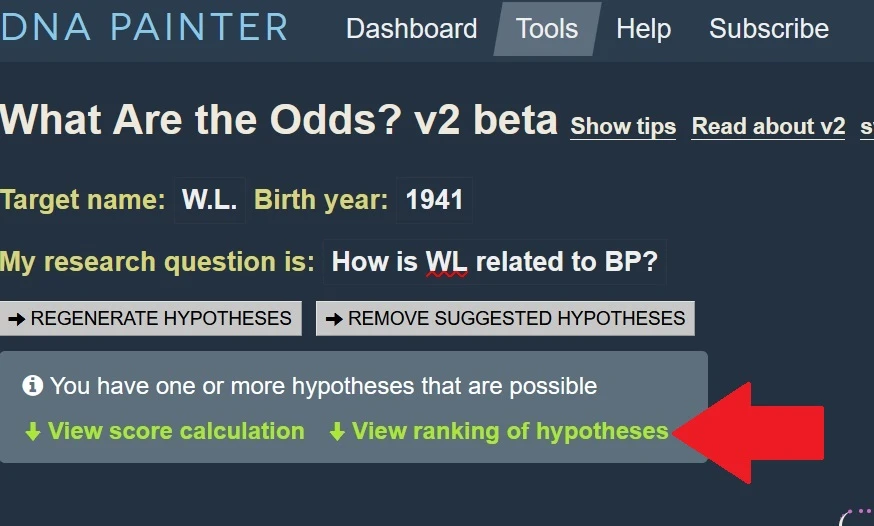
Below, you can see a selection of the hypotheses that WATO generated for my research question. I originally ran the tool testing for the two relatives I mentioned at the beginning of this post, so you can see two rows and a combined odds ratio for each hypothesis:

As you can see, most of the relationships are either second cousin (2C) or second cousin once-removed (2C1R). Those are the relationships with the highest probability.
You might notice that there are a couple closer relationships, such as first cousin once-removed (1C1R) that are theoretically possible, but with very low odds. These results essentially confirmed what I had already determined, which was that the common ancestor that my relatives share with this match is no further back than great-great grandparent, and is likely a generation closer.
For this particular research question, and the inputs that I provided, the tool generated 38 possible hypotheses. Even discarding the least probable, I am still left with about 20 possible places in my tree where this match could fit.
This exercise taught me how to use this fun and interesting tool. And, I also learned that I am unlikely to be able to narrow down my DNA cousin's place in my family tree!
20 possible spots is too many. I think it is time for me to move on from this mystery unless a new fact comes to light.
Conclusion
I hope that you enjoyed reading about this tool and that you have already thought of a few ways to use it to come up with a few new hypotheses about how some of your matches are related.
If you have any questions about something that you read here, or if you get the chance to try out the tool, please let me know in the discussion below.
Thanks for stopping by today!


Diana Fulkes
Sunday 18th of April 2021
Close Family – 1st Cousin 1,701 cM | 24% shared DNA Public linked tree 170 People
Common ancestor 1st – 2nd Cousin 589 cM | 8% shared DNA Unlinked Tree View match I do not know from which side as his Grandmother was adopted. how o I find out how we are related?
This one is my cousin although we have the same Grandmothers we have different grandfathers 1st – 2nd Cousin 363 cM | 5% shared DNA